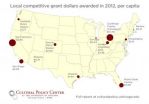(Press-News.org) Local direct public funding provided through grants for the arts in Chicago is low compared to peer regions in both total dollar and per capita terms, according to a new report from the Cultural Policy Center at the University of Chicago.
The study tracks direct public funding for the arts in 13 regions from 2002-2012. It provides a nuanced look at how much money comes to the nonprofit arts from national, state and local arts agencies, with an emphasis on the important role of local arts agencies. While most studies of public funding for the arts use appropriations made on the national and state levels and estimates of local expenditures, this report draws exact dollar figures from grant-level data.
"There are a lot of different ways that city- or regional-arts agencies and departments are structured and funded and make grants," explained Jennifer Novak-Leonard, a researcher at the Cultural Policy Center, who co-authored the report with research assistant Patience E. Baach. "This variation can make it challenging to learn from what is happening in other regions. Yet in light of recommendations in the Chicago Cultural Plan to increase public funding levels, to develop new mechanisms for doing that, and to align funding strategies with the operational realities of arts organizations, we felt an empirical look at Chicago and other regions was needed." She added, "I'd like to thank all of the agencies that shared their data with us and helped us understand this information."
In 2012, Chicago received $7.3 million in public dollars via competitive grants from local, state and national public arts agencies combined. That was more than all but three of the regions studied, but a substantial drop from the $16.5 million it received in 2002.
Chicago's drop in funding was in large part due to the Illinois Arts Council's budget being cut by more than half in 2010. Chicago received over half of its competitive arts grant dollars from that state agency, whereas of the 13 regions analyzed, eight received over half of the total competitive arts grant dollars from their local agency.
On the local level, the report does not consider programming put on by arts agencies themselves. For example, Chicago's local arts agency, the Department of Cultural Affairs and Special Events (DCASE), funds and operates the Chicago Blues Festival, the Air and Water Show and many free events in Millennium Park and Grant Park. The study excludes these, considering only grants awarded to other organizations and artists.
By that measure, DCASE provides lower levels of funding than most of the local agencies studied. In 2012, DCASE awarded $1.2 million in grants, which is $0.44 per capita. That is less in both total dollar and per capita terms than Cuyahoga County (Cleveland, Ohio), Miami-Dade County, San Francisco, San Diego, the Denver Metro Region, Houston, the Greater Columbus Area, the Portland Metro Region and Philadelphia. The other cities in the study are Baltimore, Boston and Phoenix.
Despite its relatively low funding level, over the past decade DCASE annually awarded among the highest total number of grants compared with other regions' local agencies, reaching almost a third of Chicago's nonprofit arts organizations.
"The amount of public funding available as grants to arts organizations and artists is only one measure, but an important one, of what contributes to a city's creative vitality," said Betty Farrell, Executive Director of the Cultural Policy Center, which is a joint venture of the Harris School of Public Policy and NORC at the University of Chicago. "We believe the kind of comparative lens used in this research can help highlight both the current strengths and challenges of Chicago's cultural sector."
INFORMATION:
The study, which was supported in part by Arts Alliance Illinois, follows on the heels of a report released last month by the Cultural Policy Center about the size and structure of Chicago's creative economy compared to peer cities, and one last week about how well Chicago retains its arts students after they graduate.
New report: Local public grants for art varies across US
2014-06-06
ELSE PRESS RELEASES FROM THIS DATE:
HIV transmission networks mapped to reduce infection rate
2014-06-06
Researchers at the University of California, San Diego School of Medicine have mapped the transmission network of human immunodeficiency virus (HIV) in San Diego. The mapping of HIV infections, which used genetic sequencing, allowed researchers to predictively model the likelihood of new HIV transmissions and identify persons at greatest risk for transmitting the virus.
The findings are published online in the June 5 issue of the journal PLOS ONE.
"The more we understand the structure and dynamics of an HIV transmission network, the better we can identify 'hot spots' ...
Alcohol may protect trauma patients from later complications
2014-06-06
Injured patients who have alcohol in their blood have a reduced risk for developing cardiac and renal complications, according to a study from the University of Illinois at Chicago School of Public Health. Among patients who did develop complications, those with alcohol in their blood were less likely to die.
The study is published in the June issue of the journal Alcohol.
"After an injury, if you are intoxicated there seems to be a substantial protective effect," says UIC injury epidemiologist Lee Friedman, author of the study. "But we don't fully understand why this ...
Is glaucoma a brain disease?
2014-06-06
Rockville, Md. — Findings from a new study published in Translational Vision Science & Technology (TVST) show the brain, not the eye, controls the cellular process that leads to glaucoma. The results may help develop treatments for one of the world's leading causes of irreversible blindness, as well as contribute to the development of future therapies for preserving brain function in other age-related disorders like Alzheimer's.
In the TVST paper, Refined Data Analysis Provides Clinical Evidence for Central Nervous System Control of Chronic Glaucomatous Neurodegeneration, ...
Clinical review published in JAMA
2014-06-06
Many women experience bothersome urine loss with laughing, coughing and sneezing (stress urinary incontinence) AND on their way to the bathroom (urge urinary incontinence). When women experience both types of urine leakage, their condition is called mixed urinary incontinence. It is estimated that 20 to 36 percent of women suffer from mixed urinary incontinence, which is challenging to diagnose and treat because symptoms vary and guidelines for treatment are not clear.
A clinical review entitled "Clinical Crossroads – Female Mixed Urinary Incontinence" by Deborah L. ...
Prostate cancer biomarkers identified in seminal fluid
2014-06-06
Improved diagnosis and management of one of the most common cancers in men – prostate cancer – could result from research at the University of Adelaide, which has discovered that seminal fluid (semen) contains biomarkers for the disease.
Results of a study now published in the journal Endocrine-Related Cancer have shown that the presence of certain molecules in seminal fluid indicates not only whether a man has prostate cancer, but also the severity of the cancer.
Speaking in the lead-up to Men's Health Week (9-15 June), University of Adelaide research fellow and lead ...
Toward a better drug against malaria
2014-06-06
This news release is available in German.
A research team led by Prof. Dr. Carola Hunte of the University of Freiburg/ Germany has succeeded in describing how the antimalarial drug atovaquone binds to its target protein. The scientists used x-ray crystallography to determine the three-dimensional structure of the protein with the active substance bound. The drug combination atovaquone-proguanil (Malarone®) is a medication used worldwide for the prevention and treatment of malaria. The data and the resulting findings concerning the mode of action of atovaquone could ...
Football for untrained 70-year-old men
2014-06-06
Research carried out by the Copenhagen Centre for Team Sport and Health in Denmark shows that untrained elderly men get markedly fitter and healthier as a result of playing football (soccer). After only 4 months of twice-weekly 1-hour training sessions, the men achieved marked improvements in maximum oxygen uptake, muscle function and bone mineralization.
Later today, three scientific articles will be published in the Scandinavian Journal of Medicine & Science in Sports describing the fitness and health effects of football training for 63‒75-year-old untrained men. ...
Deadly diseases overlooked for too long, scientists say
2014-06-06
Decades of neglect have allowed infectious diseases to devastate the lives of thousands of people in the developing world, a study reveals.
Researchers say three diseases in particular – anthrax, brucellosis and bovine tuberculosis – have failed to receive the official recognition and funding needed to combat them effectively.
All three impact greatly on human and animal health in developing nations, posing a major threat to safe and plentiful food supplies.
The disorders – known as zoonotic diseases – are spread between animals and humans. They are common ...
Saving trees in tropics could cut emissions by one-fifth, study shows
2014-06-06
Reducing deforestation in the tropics would significantly cut the amount of carbon dioxide emitted into the atmosphere – by as much as one-fifth – research shows.
In the first study of its kind, scientists have calculated the amount of carbon absorbed by the world's tropical forests and the amounts of greenhouse gas emissions created by loss of trees, as a result of human activity.
They found that tropical forests absorb almost two billion tonnes of carbon each year, equivalent to one-fifth of the world's carbon emissions, by storing it in their bark, leaves and soil. ...
York scientists provide new insights into biomass breakdown
2014-06-06
Scientists at the University of York are playing a key role in the quest for a better understanding of how a recently discovered family of enzymes can degrade hard-to-digest biomass into its constituent sugars.
The enzymes – lytic polysaccharide monooxygenases (LPMOs) – are secreted by both fungi and bacteria and have the ability to 'chip away' at cellulose and other intractable materials. This allows cellulosic materials such as plant stems, wood chips and cardboard waste, as well as other tricky polysaccharides such as insect/crustacean shells, to be broken down.
Finding ...


